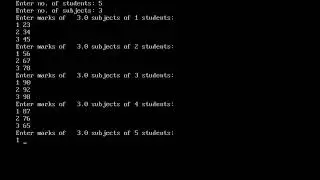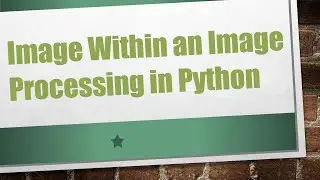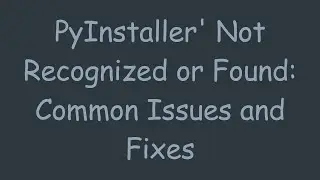How to Reverse a TXT File in Python and Add Custom Lines
Learn how to reverse the content of a text file in Python, ensuring proper formatting with new lines and additional text.
---
This video is based on the question https://stackoverflow.com/q/74662524/ asked by the user 'Steven Lindsey' ( https://stackoverflow.com/u/20670695/ ) and on the answer https://stackoverflow.com/a/74662548/ provided by the user 'TerryA' ( https://stackoverflow.com/u/1971805/ ) at 'Stack Overflow' website. Thanks to these great users and Stackexchange community for their contributions.
Visit these links for original content and any more details, such as alternate solutions, latest updates/developments on topic, comments, revision history etc. For example, the original title of the Question was: Reversing a txt File in python
Also, Content (except music) licensed under CC BY-SA https://meta.stackexchange.com/help/l...
The original Question post is licensed under the 'CC BY-SA 4.0' ( https://creativecommons.org/licenses/... ) license, and the original Answer post is licensed under the 'CC BY-SA 4.0' ( https://creativecommons.org/licenses/... ) license.
If anything seems off to you, please feel free to write me at vlogize [AT] gmail [DOT] com.
---
How to Reverse a TXT File in Python and Add Custom Lines
In the world of programming, handling text and files is a common task. One such task might be a need to reverse the lines of a text file while also inserting custom lines in between the reversed content. If you have a file named newText.txt, containing the following lines:
[[See Video to Reveal this Text or Code Snippet]]
You may wish to create a new file newerText.txt that appears like this:
[[See Video to Reveal this Text or Code Snippet]]
This guide will guide you through the process, breaking it down into manageable steps.
Understanding the Problem
The primary issue stems from the behavior of reading and writing files in Python. When reading from newText.txt, the lines are separated by newline characters (\n). If you merely reverse these lines using basic methods, there could be improper formatting when you write the text back to newerText.txt. For instance, WITHOUT proper handling, the output could look like this:
[[See Video to Reveal this Text or Code Snippet]]
Where line3 and line2 appear together without a newline in between them.
Step-by-Step Solution
Here’s how to achieve the desired output correctly.
Step 1: Read the Original File
Start by opening and reading the contents of your file, newText.txt. Python makes it straightforward to read files:
[[See Video to Reveal this Text or Code Snippet]]
Step 2: Reverse the Lines and Format Properly
Now, the key part is to reverse the lines and ensure that each line is correctly formatted with a newline character at the end. Here’s how to do this:
[[See Video to Reveal this Text or Code Snippet]]
Breakdown of Code:
reversed(lines): This function is used to invert the order of the list of lines read from the original file.
line.strip(): This removes any leading or trailing whitespace, including new line characters that may interfere with formatting.
"\n": By adding a newline character explicitly, you ensure that each line in the newly created file follows the correct format, resulting in proper separation.
Step 3: Inserting a Custom Line
Finally, to meet the requirements of inserting "Python Inserted a new line" between line 3 and line 2, you can modify the previous code slightly:
[[See Video to Reveal this Text or Code Snippet]]
Complete Code Example
Here’s the complete code that combines all the steps above:
[[See Video to Reveal this Text or Code Snippet]]
Conclusion
You have now successfully reversed the lines of a text file in Python while also inserting a custom line between them! This exercise is a great example of how file manipulation works in Python and highlights the importance of proper formatting when reading and writing data.
Feel free to experiment further with file handling to enhance your programming skills!































